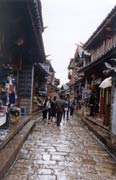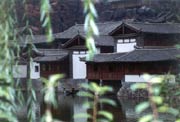| The old Lijiang County has many scenic spots
 There are many historical remains and natural scenes everywhere in the Naxi region. The old Lijiang County, which is listed by the TSCO of the UN as a world cultural heritage, is actually a "county without wall", and for thousand of years it has welcomed guests from all directions with open heart. The Sifang Street is the center of the county; four main paths stretch out connecting with small netted lanes, which is like a huge maze. Streets are paved with stones, which have been polished very smooth year in year out by footsteps and washing of wind and rain. It seems that the streets are paved with marble where there is no dust and sand when wind blows, and no mud when it rains. The houses have the styles of the Song and Ming structures and are scattered all over like stars in the sky, fish scales and comb teeth. The Yuhe River which comes out from the foot of the Xiangshan mountain in the Northern county, is divided into tens of streams when it reaches the Two Stones Bridge at the top of the county, crosses streets and lanes and flows around the county. There are streams before every house, and there are unique flowers in every yard. Because the design of "small bridges, flowing water and houses" is with consummate craftsmanship, countless scholars and travelers from home and abroad were captivated lingered on with no intention of leaving, and sigh with true feelings that what a wonderful and heavenly scenery it is! There are many historical remains and natural scenes everywhere in the Naxi region. The old Lijiang County, which is listed by the TSCO of the UN as a world cultural heritage, is actually a "county without wall", and for thousand of years it has welcomed guests from all directions with open heart. The Sifang Street is the center of the county; four main paths stretch out connecting with small netted lanes, which is like a huge maze. Streets are paved with stones, which have been polished very smooth year in year out by footsteps and washing of wind and rain. It seems that the streets are paved with marble where there is no dust and sand when wind blows, and no mud when it rains. The houses have the styles of the Song and Ming structures and are scattered all over like stars in the sky, fish scales and comb teeth. The Yuhe River which comes out from the foot of the Xiangshan mountain in the Northern county, is divided into tens of streams when it reaches the Two Stones Bridge at the top of the county, crosses streets and lanes and flows around the county. There are streams before every house, and there are unique flowers in every yard. Because the design of "small bridges, flowing water and houses" is with consummate craftsmanship, countless scholars and travelers from home and abroad were captivated lingered on with no intention of leaving, and sigh with true feelings that what a wonderful and heavenly scenery it is!
The Baisha old castle---"Stone Castle" can be seen over 100 kilometers distance in the north of Lijiang, where "if one man guards the pass, ten thousand can't get through". It was constructed on a huge rock in the Ming Dynasty, and the area of it is no larger than several hundreds square meters. Though surrounding cliffs, a two-meter high stone wall was constructed around it. The dangerous and difficult of access geographical environment and the art of unique structure make the old castle like a graceful, tall and straight magic fungus stands towering at the highest point of the Jinshajiang valley.
According to historical records, at the beginning of the Tang Dynasty, a famous chain bridge was built over the Jinshajiang River 2 kilometers from the North of the Tacheng village in Judian town, Lijiang, which could had been "the first bridge over the ten-thousand-li Yangtse River". It is a pity that the bridge was destroyed within 100 years in flames of war. Until the Guangxu period of the Qing Dynasty, a new chain bridge was built again. It lies between Lijiang and Yongshen with the name of "Golden Dragon Bridge" (commonly called Hometown Bridge). The body of the bridge is about 3 meters wide and 90 meters long, and is pulled across the river by 16 iron chains. The two sides have two protective chains for supporting hands, and thick boards are paved in the middle. The chain bridge, which is like a rainbow flying across the Jinshajiang River, is still playing an important role for the convenience of different nationalities, and for connecting the border and the interior of the motherland.
 The Baidi Township in the Southeastern Zhongdian County is a gathering place of Naxis. There is a white water dyke. The water within is carbonic acid spring, pure white and clear. The sediment of the spring piled up and coagulated into a big stretch of terraced silvery riverbed. When the red sun shines high above, the jade-like light stretches out for several miles, which presents a natural splendid and marvelous spectacle. The Baidi Township in the Southeastern Zhongdian County is a gathering place of Naxis. There is a white water dyke. The water within is carbonic acid spring, pure white and clear. The sediment of the spring piled up and coagulated into a big stretch of terraced silvery riverbed. When the red sun shines high above, the jade-like light stretches out for several miles, which presents a natural splendid and marvelous spectacle.
Near the white water dyke there is a famous metal-and-stone historical relic---cliff dedicated poem created by Mugao, who was local Naxi prefect of Lijiang in the Ming Dynasty. We know from the eight sentences of the poem that the Baidi Township is the Holy land of Naxi Dongba religion.
A nationality that still has pictographic characters <<
The old Dongba culture >>
|